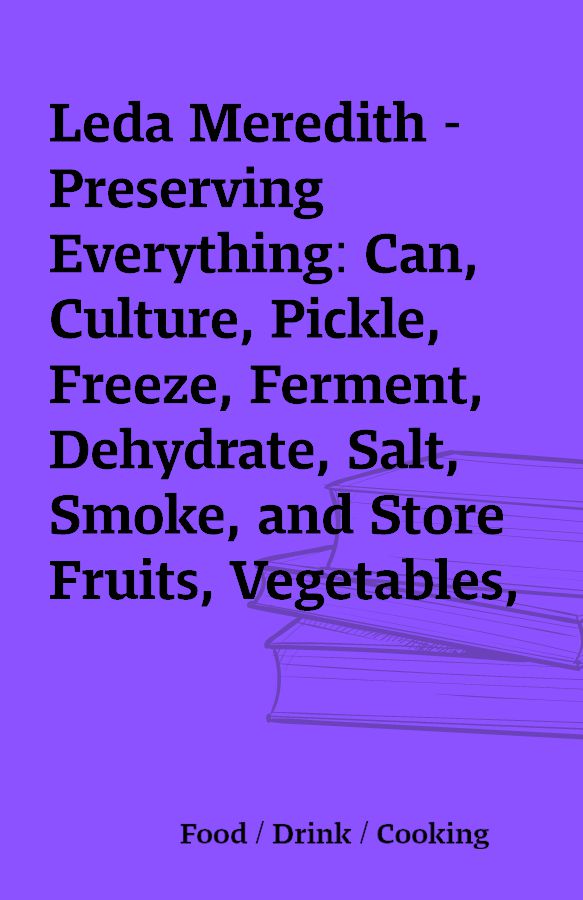Leda Meredith – Preserving Everything: Can, Culture, Pickle, Freeze, Ferment, Dehydrate, Salt, Smoke, and Store Fruits, Vegetables, Meat, Milk, and More
Leda Meredith – Preserving Everything – Can, Culture, Pickle, Freeze, Ferment, Dehydrate, Salt, Smoke, and Store Fruits, Vegetables, Meat, Milk, and More.epub
[1 Ebook – Epub]
Description
Preserving Everything: Can, Culture, Pickle, Freeze, Ferment, Dehydrate, Salt, Smoke, and Store Fruits, Vegetables, Meat, Milk, and Moreby Leda MeredithISBN: 1581572425 | 2014 | EPUB | 272 pages | 5 MBThe ultimate guide to putting up food.How many ways can you preserve a strawberry? You can freeze it, dry it, pickle it, or can it. Milk gets cultured, or fermented, and is preserved as cheese or yogurt. Fish can be smoked, salted, dehydrated, and preserved in oil. Pork becomes jerky. Cucumbers become pickles. There is no end to the magic of food preservation, and in Preserving Everything, Leda Meredith leads readers―both newbies and old hands―in every sort of preservation technique imaginable.Amazon Reviews5.0 out of 5 stars Essential Reading!By Ellen Zachos on September 3, 2014I hardly know where to start. This book is beautiful. Well organized, well laid out, well photographed. But that’s not even the important stuff. This book is a must read for everyone interested in food preservation, from beginner to the experienced preserver. I put myself in the latter category and while I knew I’d enjoy reading it, I wondered how much I’d actually learn. Ms. Meredith sure showed me! I can’t wait to try a few of her smoking and cheese-making techniques, not to mention the dehydrator jerky. I collect cookbooks and food preservation books and as I read this (from cover to cover) I thought to myself, “This is the new Ball Blue Book, only better.” The thing that appeals to me most is that the author teaches us the methods, helps us understand them (why they work), and encourages us to make them our own. Sure, she gives us demonstration recipes for each technique, but love the idea of understanding why something works the way it does, then being able to tinker on my own. This is an essential book for anyone interested in food preservation. Essential.5.0 out of 5 stars Finally, a book about food preservation that I can use front-to-backBy Blake Olmstead on August 13, 2014Tired of seeing books on single-topic methods of food preservation, I was anxious to get my hands on a copy of this book. It hasn’t disappointed. It not only offers new pointers and insights into things I was already familiar with (culturing, yogurts) but gives me the perfect practical introduction into methods new to me like lacto-fermentation, salting and smoking, and more—not to mention the perfect set of guidelines for freezing and dehydrating dozens of foods.The only disappointment I feel is when I come across a great recipe for preserving a food that has already left the farmer’s market for the year. But until I get the chance to shop for those foods next year, there is plenty to keep me occupied. I only need more counter space for all of these jars…3.0 out of 5 stars OK but needs some editing and further informationBy Ginny on April 4, 2015As others have written this is a basic guide to preserving food by many different methods. There is a lot of very useful detailed information, carefully organized and well presented on a number of different methods, including some that are as old as the hills and some that are modern and up to the minute. However, and this is a bit caveat, before using some of the recipes and/or methods, one needs to check the recipes carefully because — and a copy edit should have caught these — a lot of necessary details are missing. For instance: in the recipe for oven method kale chips the instruction for a large bunch of kale would be a lot more helpful if it gave a weight (your large bunch may be my small one), and also the oven temperature. I looked everywhere for that basic information but it isn’t there. It does mention recrisping them by baking them in a preheated 300 degree F oven for 5 minutes but no original temperature is givenAnother example is in the pages about root cellaring. A lot of very good information is included but nowhere does it mention problems with rodents and insects. Perhaps Ms. Meredith has “clamped” vegetables successfully, or stored veg and fruit in straw filled old freezers/refrigerators under ground (I sure hope that someone has removed the refrigerants and any toxic substances, as well as taken the hinges off the doors!) but if she had she would have found that such storage methods, while very handy, can lead to nasty infestations of rodents and/or bugs. You have to enclose everything in very fine wire mesh to prevent rodents bellying up to the items in a clamp, and you will have bugs. I urge anyone planning to root cellar to think very carefully about how to exclude rodents, skunks and raccoons as well as other creatures (coyotes, bears, etc.) from burrowing in.My third example is Elderflower champagne — there are four ingredients and none of them are elderflowers — surely elderflowers got omitted? Also, a way to identify elderflowers should be included and some caveats — elderberries are considered to be mildly poisonous unless cooked and according to my info, all green parts of the plant are poisonous. So if you use elderflowers make sure you only use the flowers.These are problems that I found on a quick skim. I’m sure that there are more questions that I would raise when I read through.Ms. Meredith skips lightly over preserving in oil — this is an method fraught with possible food safety issues. If you preserve garlic in oil it can lead to botulism (if I remember correctly) — she gives a recipe for infusing rosemary in oil…I’d be VERY careful about preserving anything in oil, even after heating it etc. She is very detailed in her instructions on food safety for some methods and less so on others………….So, while I think this is a very useful book, it needs some editing — perhaps in a second edition.5.0 out of 5 stars My preserving bible for all my preserving needsBy jlcrosby on August 20, 2014I read this book cover to cover. At first I thought it would be impossible to include every way to preserve in one book. I was amazingly surprised .The Author divides the ways to preserve one for each way, from dehydrating to canning to yogurts & cheese and everything in between. Each chapter includes guidelines that must be met insure food safety. It is these guidelines that the author makes the reader aware and comfortable to process anything as long as follow the guidelines. The author also includes recipes that pertain to the chapter giving the reader even more confidence to tackle preserving on their own.I have found, being very close to harvest seasons, that I have been using this as my preserving bible, as a reference as it may, for all my preserving needs.3.0 out of 5 stars Not for experienced food preservers, definitely a beginner’s book …By R. Clark on March 6, 2015Not for experienced food preservers, definitely a beginner’s book. The one recipe that I did want to try didn’t have the amount printed in my edition, so I emailed author and she graciously gave me the amounts.5.0 out of 5 stars Great readBy Hendricks on December 29, 2014Format: Paperback Verified PurchaseBirthday gift from my hubby and daughter! Love the book but haven’t gotten to try any recipes/ideas yet. Read thru and marked pages. We work so hard to grow our fruits and veggies that I hate to lose any of it. This is giving me some more ideas of different things to do. I can’t wait to try some of this out come summer and fall!4.0 out of 5 stars Love this book! Great info, needs some editingBy Wanda Yoder on November 18, 2015I saw this book in a store, so I loaned it from the library. After paging through it, I loved how useful it seemed so I had to buy it! I’ve read it cover to cover twice now and it is a great resource for preserving almost any food! It’s very easy to understand and its recipes are unique from any i ever had growing up! I love that’s it’s not just another canning book. It’s a must have for any preservation lover like me!A few things that I have noticed though is it is missing a some key bits of info in a few of the recipes. For example, the elderflower champagne does not say how much of the flowers is needed. Also I would wish that there was information on how to identify elderflowers. Also the ricotta cheese recipe calls for “3/4 citric acid dissolved in 2 Tbsp. cold water”. It doesn’t say how much citric acid is needed. These are just a couple of the editing errors I’ve picked out.Leda Meredith wrote an easy to read, very useful book. Overall, I definitely recommend this book, but I look forward to a second addition that fixes these errors.Useful note: I found the same recipe for elderflower champagne on a web site that lists the amount of elderflowers needed. “7 to 8 large (6 inch or so diameter) or double that of smaller elderflower clusters”
You must be logged in to post a review.






Reviews
There are no reviews yet.